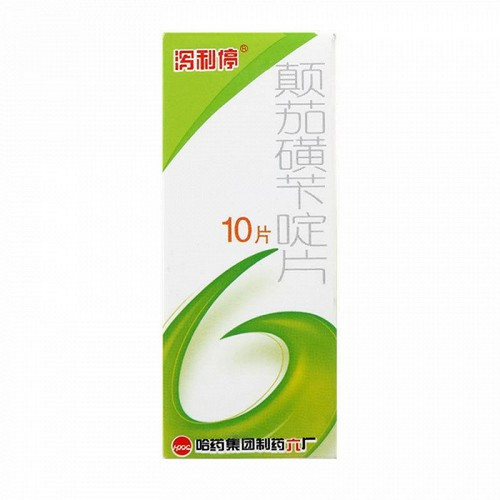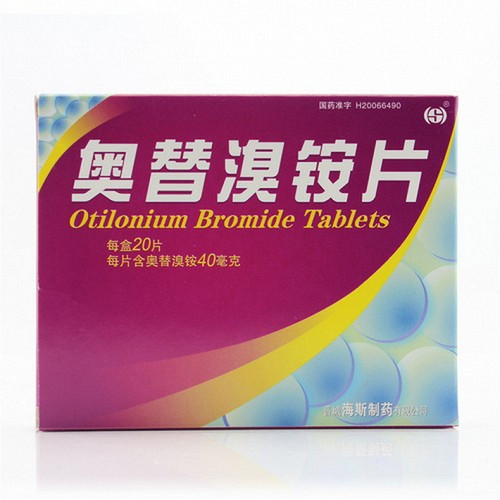Product Overview
[Drug Name]
Trade Name: Huiren
English Name: Belladonna Sulfamethoxazole and Trimerhoprim Tablets
Chinese Pinyin: Dianqie Huangbianding Pian
[Main Ingredients]
Sulfamethoxazole 0.4g, trimethoprim 80mg, belladonna fluid extract 8mg.
[Properties]
Off-white tablets
[Indications]
For chronic bacillary dysentery caused by Shigella dysenteriae and enteritis caused by other susceptible pathogens.
[Dosage and Administration]
Oral administration. 2 tablets at a time. Take 3 times on the first day, then twice daily thereafter. A course of treatment is 1-5 days. Continued use requires medical advice.
[Adverse Reactions]
1. Allergic reactions are common and may manifest as drug rashes. Severe cases may develop exudative erythema multiforme, exfoliative dermatitis, and epidermolysis bullosa atrophic dermatitis. Serum sickness-like reactions such as photosensitivity, drug fever, joint and muscle pain, and fever may also occur. Anaphylactic shock may occur occasionally. 2. Neutropenia or neutropenia, thrombocytopenia, and aplastic anemia. Patients may experience sore throat, fever, pallor, and a bleeding tendency. 3. Hemolytic anemia and hemoglobin. This is more common in patients with glucose-6-phosphate dehydrogenase deficiency after taking sulfonamides and is more common in newborns and children than in adults. 4. Hyperbilirubinemia and neonatal jaundice. Because this drug competes with bilirubin for protein binding sites, it can cause elevated free bilirubin. Neonates have imperfect liver function and poor bilirubin processing, making them more susceptible to hyperbilirubinemia and neonatal jaundice, and occasionally kernicterus. 5. Liver damage. Jaundice and decreased liver function may occur, and in severe cases, acute liver necrosis may develop. 6. Kidney damage. Crystalluria, hematuria, and casts in the urine may occur; occasionally, patients experience serious adverse reactions such as interstitial nephritis or renal tubular necrosis. 7. Nausea, vomiting, decreased appetite, diarrhea, headache, fatigue, etc., are generally mild. Occasionally, patients may develop Clostridium difficile enteritis, in which case the drug should be discontinued. 8. Thyroid enlargement and hypofunction may occasionally occur. 9. Central nervous system toxicity may occasionally occur, manifesting as confusion, disorientation, hallucinations, euphoria, or depression. 10. Dry mouth, blurred vision, increased heart rate, flushing, and dizziness. Severe cases may include mydriasis, excitement, and irritability.
[Contraindications]
1. Contraindicated in patients with allergies to SMZ and TMP. 2. Contraindicated in patients with megaloblastic anemia. 3. Contraindicated in pregnant and lactating women. 4. Contraindicated in newborns and infants under 2 months of age. 5. Contraindicated in patients with severe hepatic or renal impairment. 6. Contraindicated in patients with glaucoma or elevated intraocular pressure. 7. Contraindicated in patients with tachycardia. 8. Contraindicated in patients with benign prostatic hyperplasia. 9. Contraindicated in patients with pyloric obstruction.
[Precautions]
1. Cross-allergic reactions. Patients allergic to one sulfonamide may also be allergic to other sulfonamides. 2. Liver damage. Jaundice and decreased liver function may occur, and in severe cases, acute hepatic necrosis may occur. Therefore, patients with liver damage should avoid this drug. 3. Kidney damage. Crystalluria, hematuria, and cystic urine may occur. Therefore, while taking this drug, drink plenty of fluids to maintain a high urine flow. If this drug is used for a long course or in high doses, in addition to drinking plenty of fluids, sodium bicarbonate should be taken concurrently to prevent this adverse reaction. This drug is susceptible to renal damage in patients with dehydration, shock, or the elderly. Therefore, use of this drug should be used with caution or avoided. Patients with decreased renal function should not use this drug. 4. Patients allergic to furosemide, sulfones, thiazide diuretics, sulfonamides, and carbonic anhydrase inhibitors may also be allergic to sulfonamides. 5. Use with caution in patients with gastric and duodenal ulcers and heart failure.
[Use in Special Populations]
Precautions for Children:
Because this drug can compete with bilirubin for binding sites on plasma proteins, and because the acetyltransferase system in newborns is not fully developed, the free blood concentration of sulfonamides increases, increasing the risk of kernicterus. Therefore, this drug should be contraindicated in newborns and infants under two months of age. Children are still growing and developing, and their liver and kidney functions are not yet fully developed, so the dosage should be reduced.
Precautions During Pregnancy and Breastfeeding:
This drug can cross the placental barrier and reach the fetus. Animal studies have shown teratogenic effects. This drug is secreted in breast milk, with concentrations reaching approximately 50%-100% of the maternal blood concentration, and may affect the infant. This drug may cause hemolytic anemia in newborns with glucose-6-phosphate dehydrogenase deficiency. Therefore, this drug should not be used by breastfeeding women.
Elderly Precautions:
Elderly patients are more likely to experience serious adverse reactions when using this drug, including skin allergic reactions such as severe rash, and hematologic abnormalities such as bone marrow suppression, leukopenia, and thrombocytopenia. These reactions are more likely to occur with concomitant diuretic use. Therefore, use of this drug should be avoided in elderly patients. When indicated, the decision should be made after weighing the pros and cons.
[Drug Interactions]
1. Urine alkalinizing agents may increase the solubility of this drug in alkaline urine, leading to increased excretion. 2. Do not use this drug with para-aminobenzoic acid, as para-aminobenzoic acid may displace this drug from bacterial uptake, resulting in antagonistic interactions. 3. When used concomitantly with this drug, this drug may displace the protein binding sites of these drugs or inhibit their metabolism, resulting in prolonged drug action or toxic reactions. Therefore, the dosage of these drugs should be adjusted when used concomitantly with this drug or after taking this drug. These drugs include oral anticoagulants, oral hypoglycemic agents, methotrexate, phenytoin sodium, and thiopental sodium. 4. Concomitant use with myelosuppressive drugs may enhance the adverse effects of these drugs on the hematopoietic system, such as leukopenia and thrombocytopenia. If coadministration of these two drugs is indicated, close observation for possible toxic reactions should be conducted. 5. Long-term coadministration with contraceptives (estrogens) may reduce contraceptive reliability and increase the chance of extramenstrual bleeding. 6. Concomitant use with thrombolytic drugs may increase their potential toxic effects. 7. Concomitant use with hepatotoxic drugs may increase the incidence of hepatotoxicity. Liver function should be monitored in such patients, especially those taking these drugs for a long time and those with a history of liver disease. 8. Additive photosensitivity may occur when used in combination with photosensitizing drugs. 9. Patients receiving this drug have an increased requirement for vitamin K. 10. Concomitant use with methenamine is not recommended, as methenamine decomposes in acidic urine to produce formaldehyde, which can form an insoluble precipitate with this drug, increasing the risk of crystalluria. 11. This product can replace the plasma protein binding sites of phenylbutazone, and when used together, it can enhance the effects of phenylbutazone. 12. When used concomitantly with this product, sulfinpyrazone can reduce the latter's secretion from the renal tubules. Prolonged elevations in blood concentrations can easily lead to toxic reactions. Therefore, the dose of this product may need to be adjusted during or after sulfinpyrazone treatment. When sulfinpyrazone treatment is prolonged, monitoring the blood concentration of this product is advisable to facilitate dose adjustment and ensure safe use. 13. The trimethylolpropane (TMP) in this product can inhibit the metabolism of warfarin and enhance its anticoagulant properties. 14. The TMP in this product can increase nephrotoxicity when used concomitantly with cyclosporine. 15. When used concomitantly with this product, rifampicin can significantly increase the clearance of TMP in this product and shorten its serum half-life. 16. This product should not be used concomitantly with antineoplastic drugs or 2,4-diaminopyrimidines, nor between courses of treatment with other folic acid antagonists, as it may cause bone marrow aplasia or megaloblastic anemia. 17. Do not use with dapsone, as the combined use of dapsone and the trimethoprim (TMP) in this product can increase the blood concentrations of both drugs. This increased dapsone concentration can increase and aggravate adverse reactions, especially methemoglobinemia. 18. Avoid co-administration with penicillins, as this product may interfere with the bactericidal effects of these drugs.
[Pharmacological Actions]
This product is a combination preparation, a broad-spectrum sulfonamide antibacterial agent. Sulfamethoxazole (SMZ) and trimethoprim (TMP) exhibit synergistic antibacterial and bactericidal effects. It has excellent antibacterial activity against non-enzyme-producing Staphylococcus aureus, Streptococcus pyogenes, Streptococcus pneumoniae, Escherichia coli, Klebsiella, Salmonella, Proteus, Morganella, Shigella, and other Enterobacteriaceae, as well as gonococci, Neisseria meningitidis, and Haemophilus influenzae. The antibacterial activity against Escherichia coli, Haemophilus influenzae, and Staphylococcus aureus is significantly enhanced compared to SMZ alone. In addition, it exhibits good in vitro antimicrobial activity against Chlamydia trachomatis, Nocardia asteroides, protozoa, and Toxoplasma gondii. The mechanism of action of this drug is as follows: SMZ acts on dihydrofolate synthase, interfering with the first step of folate synthesis, while TMP acts on the second step of folate anabolism, selectively inhibiting dihydrofolate reductase. Combined use of these two drugs results in a dual blockade of bacterial folate metabolism. The synergistic effect of this drug is enhanced compared to either drug alone, resulting in a decrease in resistant strains. However, bacterial resistance to this drug has also been increasing in recent years. Belladonna is an M cholinergic receptor blocker that inhibits the muscarinic effects of acetylcholine, primarily by suppressing the activity of acetylcholine at the autonomic effector sites of postganglionic cholinergic nerves. This also inhibits the activity of smooth muscle innervated by acetylcholine. This suppresses the activity of smooth muscle, myocardium, the sinoatrial and atrioventricular nodes, and exocrine glands. Larger doses of Belladonna can also reduce gastrointestinal motility and secretion, reduce ureteral and bladder tone, and only slightly relax the common bile duct and gallbladder.
[Storage]
Store in a dry, airtight container away from light.
[Specifications:
Sulfamethoxazole 0.4g, trimethoprim 80mg, belladonna fluid extract 8mg
[Packaging]
12 tablets/box
[Expiry Life]
36 months.
[Approval Number]
National Medicine Standard H36022310
[Manufacturer]
Company Name: Jiangxi Huiren Pharmaceutical Co., Ltd.








